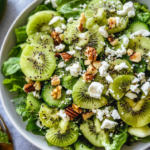Beets: Earthy, Sweet, and Nutrient-Rich
The star of this dish is undoubtedly the roasted beet. Roasting transforms beets from dense and earthy to tender and sweet, with a depth of flavor that’s hard to beat. The process caramelizes the natural sugars in the beets, softening their intensity and enhancing their richness. When sliced and served over greens, they add not just flavor, but a beautiful pop of color—ranging from deep burgundy to golden amber depending on the variety used.
Beets are more than just beautiful—they’re incredibly good for you. Rich in fiber, folate, potassium, and antioxidants like betalains, they support heart health, reduce inflammation, and can even enhance athletic performance. Their natural sweetness also offers a wonderful contrast to the other savory and tangy components in the salad.
Goat Cheese: Creamy and Tangy Perfection
Goat cheese plays a crucial role in creating balance in this salad. Its creamy texture and bright tang offset the earthy sweetness of the beets, adding richness and a bit of sharpness that wakes up the palate. Crumbled over the top, goat cheese offers little pockets of creamy decadence that melt into the dressing and coat the greens for added indulgence.
Its slightly acidic profile complements the balsamic vinaigrette and adds a touch of sophistication to the dish. You can use traditional chèvre for a tangier flavor, or experiment with herbed or honey-infused goat cheese for subtle variations in taste.
Mixed Greens: A Fresh and Light Foundation
The base of this salad is a medley of mixed greens—typically arugula, baby spinach, or spring mix. These greens provide a light, peppery counterbalance to the richness of the beets and goat cheese. Arugula, in particular, adds a slightly spicy note that cuts through the sweetness of the beets, while baby spinach contributes a tender, buttery texture.
These greens also offer plenty of nutrients, including vitamin K, vitamin A, folate, and iron, making them more than just a decorative base. Their subtle flavors allow the beets and goat cheese to shine while still contributing their own character to the overall dish.
Walnuts: Crunch and Warmth
Toasted walnuts bring an essential crunch to this salad, introducing texture and a subtle, nutty flavor that enhances the other components. Toasting the walnuts intensifies their flavor and aroma, bringing warmth to the salad that contrasts nicely with the cool, creamy goat cheese.
Walnuts are also rich in omega-3 fatty acids, protein, and antioxidants, making them a heart-healthy and brain-boosting addition. They lend not only crunch but also nutritional value, rounding out the salad with healthy fats and added satisfaction.
The Balsamic-Dijon Vinaigrette: A Tangy, Velvety Finish
The vinaigrette ties all the ingredients together with a simple yet flavorful combination of olive oil, balsamic vinegar, Dijon mustard, salt, and pepper. The balsamic provides a deep, slightly sweet tang that complements the natural sugars in the beets, while the mustard adds sharpness and emulsifies the dressing for a silky finish.
Drizzled over the salad just before serving, the vinaigrette enhances each ingredient without overpowering it. It seeps into the goat cheese, clings to the greens, and adds depth to every bite. You can also customize the dressing with a touch of honey, crushed garlic, or a hint of orange zest for a personal touch.
Elegant Enough for Entertaining, Easy Enough for Everyday
One of the best things about this salad is its versatility. It feels fancy enough to serve at dinner parties or holiday meals, yet it’s easy and fast enough to make for a weeknight dinner or simple lunch. With just a bit of prep—mainly roasting the beets and toasting the walnuts—you can assemble this salad in minutes.
Because it’s served cold or at room temperature, it’s ideal for make-ahead meals or as part of a buffet. You can roast the beets a day in advance and store them in the refrigerator until ready to slice and serve. The dressing can also be prepared ahead and stored separately until it’s time to eat.
A Customizable Classic
This salad is easily adaptable to suit a variety of tastes and dietary needs. You can substitute the walnuts with pecans, almonds, or pumpkin seeds for a nut-free version. If you’re dairy-free, opt for a vegan goat cheese alternative or skip it altogether—the salad is still delicious without it.
To turn this side dish into a full meal, consider adding a protein such as grilled chicken, seared salmon, or quinoa. A grain like farro or wild rice can also make the salad more filling while adding chewy texture and whole grain goodness.
Seasonal variations are also welcome. In the fall, add sliced apples or pears for extra sweetness. In the summer, try incorporating fresh berries like strawberries or raspberries for a juicy burst that pairs wonderfully with both beets and goat cheese.
Health Benefits in Every Bite
Beyond its flavor and beauty, Roasted Beet and Goat Cheese Salad is a nutritional powerhouse. It’s high in fiber, loaded with antioxidants, and rich in essential vitamins and minerals. The combination of leafy greens, root vegetables, nuts, and healthy fats makes it a smart choice for those seeking balance and nourishment in their meals.
Beets support liver detoxification and improve blood flow. Goat cheese provides protein and calcium while being easier to digest for many people compared to cow’s milk cheese. Olive oil and walnuts contribute heart-healthy fats, and the overall low glycemic load of the salad makes it a great option for blood sugar balance.
Conclusion
Roasted Beet and Goat Cheese Salad is a standout dish that proves salads can be so much more than an afterthought. It brings together a symphony of textures and flavors—sweet, earthy, creamy, tangy, and crunchy—in a visually stunning and nutritionally balanced creation. Whether you’re serving it as a light starter, a colorful side, or a main course with a few additions, it never fails to impress.
This salad is the perfect fusion of simplicity and sophistication. It’s quick to prepare, endlessly adaptable, and universally appealing, making it a must-have in any cook’s repertoire. Once you try it, you’ll find yourself returning to it again and again, not just for the flavor, but for the joy it brings to the table.






